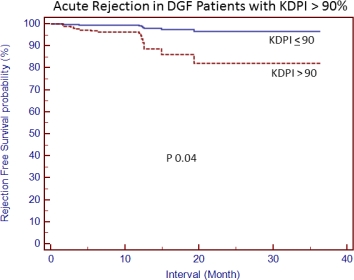High KDPI Is a Predictor of Acute Rejection in Delayed Graft Function.
1Department of Medicine, Division of Nephrology, University of Wisconsin School of Medicine and Public Health, Madison, WI
2Department of Surgery, Division of Transplantation, University of Wisconsin School of Medicine and Public Health, Madison, WI.
Meeting: 2016 American Transplant Congress
Abstract number: B190
Keywords: Kidney transplantation, Rejection, Risk factors
Session Information
Session Name: Poster Session B: Kidney Transplantation: KDPI, HCV/Matching, Donor Age
Session Type: Poster Session
Date: Sunday, June 12, 2016
Session Time: 6:00pm-7:00pm
 Presentation Time: 6:00pm-7:00pm
Presentation Time: 6:00pm-7:00pm
Location: Halls C&D
The kidney donor profile index (KDPI) is a prognostic measure for graft function and survival. It is unclear whether it predicts acute rejection in patients with delayed graft function (DGF).
We examined the outcomes of acute rejection (AR), graft loss and death in the first post transplant year in 135 patients with DGF after deceased donor kidney transplantation between July 2011 and August 2014. 14 patients underwent desensitization with plasma exchange (PLEX). 86 (64%) received basiliximab induction, 44 (33%) patients received ATG and 5 (4%) received both basiliximab and ATG induction. All patients received steroids, myfortic and tacrolimus. High-risk patients received myfortic 720 mg TID (total dose 2,160 mg daily).
There were 10 graft failures and 3 patient deaths in the first year. 30 patients (22%) had AR: 24 (18%) had acute cellular rejection, 2 (1.4%) had antibody mediated rejection and 4 (3%) had mixed rejection. KDPI > 90% (and not KDPI > 85%) was associated with AR in DGF patients (figure 1). 
In univariate Cox regression analyses, African American ethnicity, cold ischemia time, ECD, DCD, ATG, basiliximab, tacrolimus level were not associated with acute rejection. Caucasian race was associated with lower risk of AR while HLA mismatch >3, myfortic dose > 1440 mg, peak PRA > 90%, PLEX, post reperfusion biopsy C4d positivity and KDPI > 90% were associated with greater risk of rejection (table 1). Of these variables, only KDPI > 90% was retained in multivariate analyses. 
High KDPI may be an important predictor of acute rejection in DGF in the current era of immunosuppression.
CITATION INFORMATION: Muth B, Turk J, Parajuli S, Mandelbrot D, Mohamed M, Redfield R, Kaufman D, Djamali A. High KDPI Is a Predictor of Acute Rejection in Delayed Graft Function. Am J Transplant. 2016;16 (suppl 3).
To cite this abstract in AMA style:
Muth B, Turk J, Parajuli S, Mandelbrot D, Mohamed M, Redfield R, Kaufman D, Djamali A. High KDPI Is a Predictor of Acute Rejection in Delayed Graft Function. [abstract]. Am J Transplant. 2016; 16 (suppl 3). https://atcmeetingabstracts.com/abstract/high-kdpi-is-a-predictor-of-acute-rejection-in-delayed-graft-function/. Accessed December 29, 2025.« Back to 2016 American Transplant Congress
